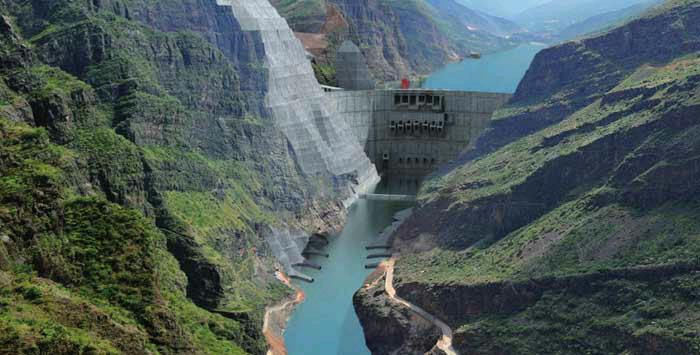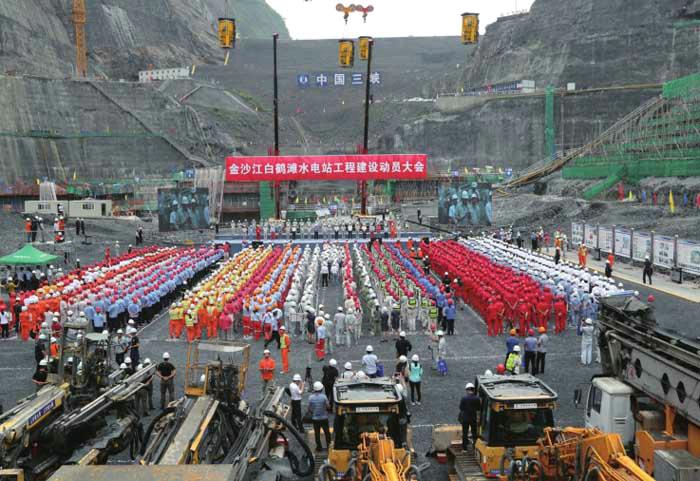Turning the Tide
2017-09-02ByMaXiaowen
By+Ma+Xiaowen
It came as a bolt from the blue for Liao Chaoan when he was told he would have to relocate with his family since his plot of land was required to build a hydropower station. It was the Baihetan Power Station, part of a behemoth project that would involve building a massive dam and a reservoir.
Liao, who lived in a mountainous village in Qiaojia County, southwest Chinas Yunnan Province, had several concerns. He wondered what life would be like after they moved to the new residential area allocated for them and what they would live on after the compensation money ran out. He was also worried that he would have to fork out extra money for water and fi rewood, which he had been getting from the mountains for free.
Liaos fears were shared by many. To build the huge dam and the reservoir at the junction of Sichuan and Yunnan, over 100,000 people in six counties of the two provinces would have to be moved elsewhere.
People-first project
The Baihetan project on the Jinsha River, the upper section of the Yangtze River, kicked off on August 3.
With an installed capacity of 16 million kw, it is expected to generate more than 60 billion kwh of electricity per year after it becomes operational in 2021. Earmarked an investment of 177.89 billion yuan ($26.50 billion), its major functions will be power generation and flood control. It will be one of the backbone suppliers in the grid transmitting electricity from west China to the countrys eastern part. Ancillary work on the project, such as building roads and communications facilities, has been completed.
The full hydropower project on the lower reaches of the Jinsha River, approved by the State Council, Chinas cabinet, in 2011, involves building three more hydropower stations besides Baihetan—Wudongde, Xiluodu and Xiangjiaba. Their combined installed capacity totals 46.46 million kw, twice as large as that of the Three Gorges Dam project on the Yangtze, Chinas largest hydro plant.
Xiluodu (1.39 million kw) and Xiangjiaba (6.4 million kw) are currently Chinas second and third largest hydropower stations respectively, which began generation in 2014. Wudongde followed suit in December 2015.
Fan Qixiang, Vice President of China Three Gorges Corp., once called Baihetan a new model of clean energy construction, which will provide new momentum to the economy in west China. Fans company is the developer of all the four hydropower stations on the lower reaches of the Jinsha River and the Three Gorges Dam project.
The clean power generated by Baihetan is estimated to cut Chinas carbon dioxide emissions by 500 million tons, according to China Three Gorges.
The Baihetan Dam is technically challenging due to its complicated geology. But a still more arduous task for the project developer is the relocation of the 100,000 residents affected as most of the six counties where they live are poverty-stricken and lack land resources.
“Since we wanted to develop the local economy, we gave the dislocated residents compensation at a higher rate,” Yao Yuanjun, chief of China Three Gorges Relocation Bureau, told Beijing Review. Over 70 billion yuan ($10.4 billion), which means nearly half the investment, was spent on paying compensation, according to Yao.
Preparations for the relocation began in 2011 as soon as the Baihetan project was given the green light by the State Council. With one years field investigations and four years of planning, consultations and filing notices, the preparatory work completed in 2016. From August 1 this year, the actual relocation started.
The residents are free to choose from two options: either move into apartments built by the developer or build houses themselves with the additional funds provided for that. Perhaps the most important concern for many, like Liao, is how to lead a better life in future.
Yao said one of the relocation targets is making sure the migrants standards of living are improved. To achieve that, China Three Gorges is improving the basic infrastructure and public service facilities in the relocation settlements. Yao said his company would build 52 residential communities, 44 river ports and roads. Besides, they are sponsoring vocational training to migrants and have reserved somejob opportunities for those with the required skills.
Fish counts
There is another major concern. “Protecting the local environment and biodiversity is as important as generating electricity,” said Sun Zhiyu, Director of China Three Gorges Environmental Protection Department.
Sun said Baihetans environmental protection plan has been implemented in tandem with designing and building the project. Conservation of the biological environment has been given priority. The Baihetan Dams design was changed to nearly double the planned water fl ow rate and revise the water pressure to ensure the breeding of fish downstream. The 300-meter-high dam will also have a system to maintain the water temperature at its natural level to minimize any impact on the fi sh.

When a dam is built, ensuring that the fi sh living in the waters can move across it freely is a major challenge, not only for Sun but for experts in this fi eld worldwide. Since the water temperature and pressure are critical for local fish species and different fish have different characteristics, ensuring the pre-dam natural condition is of the utmost importance. Or else, as Sun explained, some fi sh would simply keep on throwing themselves at the wall of the dam instead of swimming around it.
“We have been conducting research on fish trails and a systematic transport system for them for five years,” Sun said. In this, China Three Gorges has been working with renowned research institutes, including the Chinese Academy of Sciences and the Chinese Academy of Agricultural Sciences.
Sun and his team are also working to clean up several tributaries of the Jinsha River. One of them is the Heishui River, infamous for its polluted waters, where they labored to improve the water quality and protect local fi sh species.
What is Suns take on the dam vs. environment debate? “The ultimate goal of building a dam is to serve human needs,” he said. “We are always willing to turn negative impacts into good ones, and we are most certainly willing to create the most advantageous conditions for people and the environment.”
